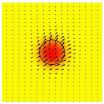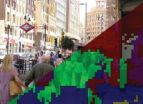(Press-News.org) COLUMBIA, Mo. – Studies show that nearly half of all Americans have difficulty understanding health information. Confusing medical directions, such as dosage and timing of prescription medicine, can lead to serious consequences including health setbacks, inappropriate hospital admissions and, sometimes, death. Now, researchers at the University of Missouri School of Health Professions are examining what health care facilities can do to increase patient understanding and positive outcomes.
Diane Smith, an assistant professor in MU's Department of Occupational Therapy and a collaborator with the University of Missouri's Center for Health Policy, and four occupational therapy graduate students conducted a pilot study focusing on the "health literacy environment" of two health care facilities. "Health literacy" is defined as a patient's ability to understand the health information provided to them by health professionals. The study focused on ease of navigation, including use of signage, facility maps and verbal & written communication.
"Our study is directed toward the provider making health information easier to understand for the client," said Smith, who is the interim chair of the occupational therapy department. "If patients can understand information better, they are going to be more compliant with medical direction. If they are more compliant, they are more likely to get better outcomes."
The study examined a rehabilitation facility and an independent senior-living facility. Although both facilities exhibited many strong points, both had areas in need of improvement. At the independent living facility, paperwork was written at a college-sophomore reading level. Previous studies have recommended that medical information be written at a fifth to eighth-grade reading level. Another common health literacy issue is clear oral communication between health care professionals and patients. At the rehabilitation facility, health care professionals rarely asked patients if they were "being clear." Problems with oral communication also extend to a lack of availability of multilingual employees who can translate for providers. Following the evaluation, the researchers gave suggestions to each facility.
Smith recommends several steps that the health care industry can take to increase patient understanding:
Health care professionals should use plain language, instead of professional jargon, as well as make sure a patient understands their directions.
Printed materials should be available in large, easy-to-read fonts and written at a fifth to eighth grade level.
Clear maps and consistent navigational signs should be posted throughout the interior, as well as on the exterior of the building.
Wheelchair accessibility also should be a consideration beyond mobility. For example, maps should be posted at wheelchair-level.
Smith is working to educate current and future health care professionals on the importance of patient understanding by speaking at professional conferences and advocating curriculum changes. This year, Smith has spoken and is scheduled to speak at professional conferences for rehabilitation professionals including occupational and speech therapists. MU's School of Health Professions also has added a health care literacy requirement to some of its degree programs.
"Health literacy is even more important as people are being discharged sooner from hospitals and are charged with their own care," Smith said. "I don't think miscommunication with patients is anything that anyone does on purpose. To facilitate better understanding, health literacy is something that should be more on the forefront of curriculum."
INFORMATION:
Smith is planning a future study focusing on more health care facilities in Missouri. The study was published in the journal Occupational Therapy in Health Care.
What can health-care facilities do to help patients better understand medical information
2010-09-16
ELSE PRESS RELEASES FROM THIS DATE:
New study finds milk drinkers may have a healthy weight advantage
2010-09-16
Now there's a new reason to grab a glass of milk when you're on diet, suggests a new study published in the American Journal of Clinical Nutrition. In a 2-year weight loss study, milk drinkers had an advantage over those who skipped the milk. Israeli researchers found that adults who drank the most milk (nearly 2 glasses per day) and had the highest vitamin D levels at 6 months, lost more weight after 2 years than those who had little or no milk or milk products -- nearly 12 pounds weight loss, on average.
Researchers also found that each additional 6-ounce serving of ...
New wave: Spin soliton could be a hit in cell phone communication
2010-09-16
VIDEO:
This animation shows the development of the soliton over the course of about 2.7 nanoseconds. Current begins passing through the channel in the center, causing the magnetization to oscillate....
Click here for more information.
Researchers at the National Institute of Standards and Technology (NIST) have found theoretical evidence* of a new way to generate the high-frequency waves used in modern communication devices such as cell phones. Their analysis, if supported ...
Rice study examines how bacteria acquire immunity
2010-09-16
HOUSTON -- (Sept. 15, 2010) -- In a new study this week, Rice University scientists bring the latest tools of computational biology to bear in examining how the processes of natural selection and evolution influence the way bacteria acquire immunity from disease.
The study is available online from Physical Review Letters. It builds upon one of the major discoveries made possible by molecular genetics in the past decade -- the revelation that bacteria and similar single-celled organisms have an acquired immune system.
"From a purely scientific perspective, this research ...
Research shows radiometric dating still reliable (again)
2010-09-16
Recent puzzling observations of tiny variations in nuclear decay rates have led some to question the science of using decay rates to determine the relative ages of rocks and organic materials. Scientists from the National Institute of Standards and Technology (NIST), working with researchers from Purdue University, the University of Tennessee, Oak Ridge National Laboratory and Wabash College, tested the hypothesis that solar radiation might affect the rate at which radioactive elements decay and found no detectable effect.
Atoms of radioactive isotopes are unstable and ...
Children's brain development is linked to physical fitness
2010-09-16
CHAMPAIGN, lll. – Researchers have found an association between physical fitness and the brain in 9- and 10-year-old children: Those who are more fit tend to have a bigger hippocampus and perform better on a test of memory than their less-fit peers.
The new study, which used magnetic resonance imaging to measure the relative size of specific structures in the brains of 49 child subjects, appears in the journal Brain Research.
"This is the first study I know of that has used MRI measures to look at differences in brain between kids who are fit and kids who aren't fit," ...
NIST data: Enabling the technical-basis for evacuation planning of high-rise buildings
2010-09-16
Researchers at the National Institute of Standards and Technology (NIST) are stepping up the pace for designing safer building evacuations by releasing large, numerical data sets that track the movement of people on stairs during high-rise building evacuation drills. The data sets will ensure that architects, engineers, emergency planners and others involved in building design have a strong technical basis for safer, more cost-effective building evacuations.
"While stairs have been used in buildings for ages, there is little scientific understanding of how people use ...
New GSI website experience puts product standards on the map
2010-09-16
Those looking for the latest product standards-related news, regulatory developments, events and workshops around the world now can turn to the new Global Standards Information (GSI) Web site (http://gsi.nist.gov). Launched on Sept. 1, 2010, the new site includes a variety of interactive tools and will serve as an essential "first stop" for users seeking up-to-date information on international product standards.
"Given the rapid adoption and complexity of new product standards both locally and globally, we realized we needed to create a new way for our customers to find ...
NIST finalizes initial set of smart grid cyber security guidelines
2010-09-16
The National Institute of Standards and Technology (NIST) has issued its first Guidelines for Smart Grid Cyber Security, which includes high-level security requirements, a framework for assessing risks, an evaluation of privacy issues at personal residences, and additional information for businesses and organizations to use as they craft strategies to protect the modernizing power grid from attacks, malicious code, cascading errors and other threats.
The product of two formal public reviews and the focus of numerous workshops and teleconferences over the past 17 months, ...
New supercomputer 'sees' well enough to drive a car someday
2010-09-16
New Haven, Conn.—Navigating our way down the street is something most of us take for granted; we seem to recognize cars, other people, trees and lampposts instantaneously and without much thought. In fact, visually interpreting our environment as quickly as we do is an astonishing feat requiring an enormous number of computations—which is just one reason that coming up with a computer-driven system that can mimic the human brain in visually recognizing objects has proven so difficult.
Now Eugenio Culurciello of Yale's School of Engineering & Applied Science has developed ...
Placebo successful in treating women with sexual dysfunction
2010-09-16
A new study published in the Journal of Sexual Medicine reveals that women with low sexual arousal experienced clinically significant symptom changes after taking a placebo.
Andrea Bradford, Ph.D., a psychologist at Baylor College of Medicine, along with co-author Cindy Meston, Ph.D. at the University of Texas at Austin, analyzed the behaviors and symptoms of 50 women who were randomly chosen to receive placebo in a large clinical trial of a drug treatment for low sexual arousal. Neither the women nor the study doctors knew whether they were taking the real drug or placebo.
Results ...



